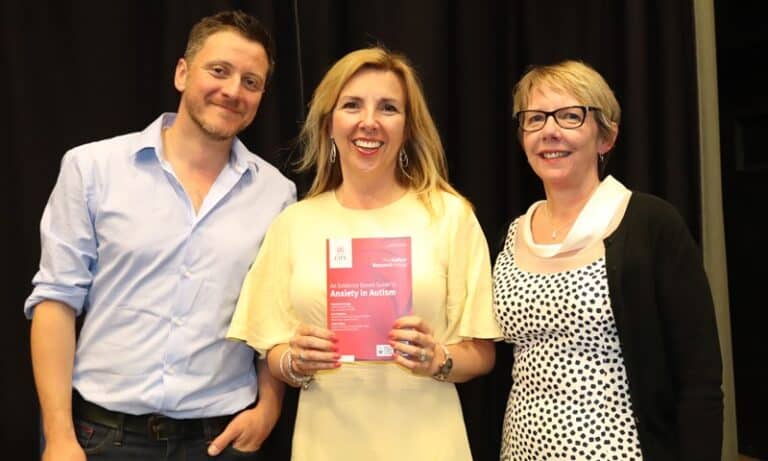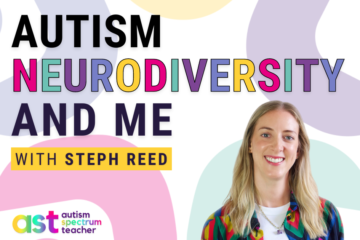Table of Contents
Podcast: Play in new window | Download
Subscribe: Spotify
Podcast Episode Notes

In this episode of the podcast, it was such a pleasure to speak with Jane Crawford and Helen Cottell from the West Sussex County Council Autism and Social Communication Team. They have recently put together an evidence based guide to anxiety in autism with Sebastian Gaigg from the Autism Research Group at City University of London.
The guide gives a brilliant summary of what is currently understood about anxiety in autism. One of the key and significant findings is that “anxiety disorder is not simply a part of autism, but an independent co-occurring disorder that can be addressed and treated in its own right”.
It can be difficult to identify anxiety disorder in autism, as it will often present in an ‘unusual’ way. For example, social anxiety may manifest not because the autistic individual is worried about being embarrassed in a social situation, but because they may find it difficult to navigate a social situation.
The statistics:
The research shows that while 10 to 15% of the general population will have an anxiety disorder at some point in their life 40% of autistic children Adolescents and adults are thought to have at least one and often more anxiety disorders.
Anxiety disorder is clearly more prevalent in the autism population. It is however ‘not part of autism’ and therefore needs to be treated as a separate entity.
Neurotypicals can often generalise strategies to help anxiety, whereas autistic individuals may find it difficult to generalise and therefore may need support to learn a new strategy for a new situation.
Possible causes of anxiety in autism:
Alexithymia: difficulties in understanding ones own emotions
Intolerance of uncertainty: as a result of sensory processing differences leads to unpredictability.
At a basic level, ‘intolerance of uncertainty’ + ‘alexithymia’ = anxiety in autism.
However it is more complex than that.
- The sensory processing differences which are part of the autistic condition, will often contribute to the intolerance of uncertainty. For example, a difficulty with or not being able to predict how the sensory system will respond next.
- What the City, University of London describe as as ‘maladaptive emotional regulation’ which is the difficulty to self-regulate emotionally. A difficulty we often see in the pupils we work with, where they may overreact, or sometimes under react to situations (for example, when they get feedback on their school work). This is clearly affected by alexithymia (the difficulty in understanding one’s own emotions) which is in turn impacted by the interoceptive sense (internal processes such as emotional feelings, temperature and pain) which links back to sensory processing differences/ difficulties. Individuals may have difficulties both understanding their emotions, which may then make it difficult for them to effectively regulate their emotions.
- The final part of the model identified by City University of London is repetitive behaviours. These may help to reduce the intolerance of uncertainty as they are under the control of the individual and are therefore more predictable and so may contribute to reducing anxiety.
Some effective strategies to help reduce and manage anxiety (which are explained further in the guide):
- ‘Intolerance of uncertainty’: Social Stories and Comic Strip Conversations plus the Zones of Regulation program, introduces a holistic approach working on all the elements that support effective self-regulation.
- Sensory processing: Working with the individual to develop their own sensory profile (which may change over time) then introduce preventative supports and activities such as Sensory Circuits as well as reactive sensory supports and activities.
- Alexithymia: Many autistic individuals (50%) have difficulties identifying and describing their own emotions. Mindfulness can have an impact as individuals begin to listen and learn to the internal messages their body is giving, supporting their interoceptive sense development. City University of London research suggests that mindfulness cognitive behaviour therapy (CBT) programme had the most impact for the most sustained amount of time.
Having a good understanding of autism is probably the most important factor in developing strategies and putting support in place for an autistic pupil with anxiety.
A lack of understanding may be the biggest contributor to an autistic individuals intolerance of uncertainty.
Understanding the social and sensory differences of an individual will help indicate what may constitute their intolerance of uncertainty and what the impact of their sensory processing difference might be on them.
A huge thank you to Jane and Helen for your time recording this podcast and for all of this really helpful information!
In the ‘Evidence Based Guide to Anxiety in Autism’ find further information about:
- What causes anxiety in autism
- Sensory processing differences
- Alexithymia
- Anxiety treatment approaches
- Tools to support anxiety management
- Emotional awareness tools
- Intolerance of uncertainty tools

